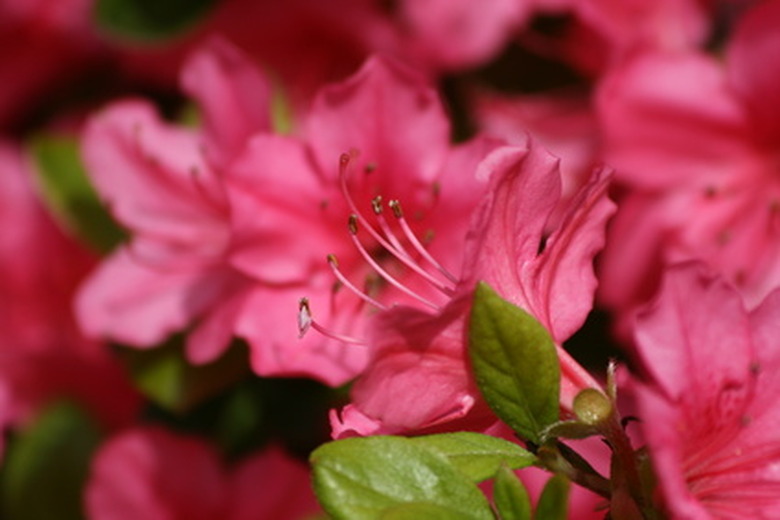Causes For Yellow Leaves On Azalea Plants
Azaleas have been known to live several hundred years, according to the Azalea Society of America. They have minimal care requirements to maintain their overall health and prevent disease. When an azalea becomes afflicted with a disorder or pest it begins to exhibit symptoms such as yellowing leaves. When the culprit is identified and treated early the azalea will suffer no adverse affects and will go on to live a healthy life.
Chlorosis
An azalea begins to suffer from chlorosis when there is a serious iron deficiency in the soil. This occurs when the pH of the soil is high. The plants leaves turn light green and then fade to yellow. The veins of the leaves remain green, but the rest of the leaf turns brilliant yellow and finally paper white. The yellowing foliage begins on the top of the shrub and gradually works its away downward until the entire shrub appears sick.
- Azaleas have been known to live several hundred years, according to the Azalea Society of America.
- The yellowing foliage begins on the top of the shrub and gradually works its away downward until the entire shrub appears sick.
Treat the soil by adding iron chelate, fine sulfur or ferrous sulfate according to the Azalea Society of America. Spraying the foliage of the azalea with iron chelate will help the plant recover its overall green appearance within one week of application.
Spider Mites
The spider mite feeds on the underside of the azalea leaves and stems by sucking the sap from the shrub using its powerful mouth. The destructive eating causes the leaves to appear blotchy yellow . The tiny insects often appear red, brown or black. The mites are quite small and often hard to see with the naked eye. Look for fine webbing on the azalea's foliage for an indication of spider mite infestation.
- Treat the soil by adding iron chelate, fine sulfur or ferrous sulfate according to the Azalea Society of America.
- The spider mite feeds on the underside of the azalea leaves and stems by sucking the sap from the shrub using its powerful mouth.
Control spider mites using acephate or dimethoate. Focus on the underside of the leaves when spraying with the insecticide. Repeat the application in 7 days for full control.
Spraying the azalea shrub's foliage every few days with a high burst of water also helps remove spider mites without the use of insecticides. But washing the foliage must be repeated every few days.
Stung Nematode
The stunt nematode (Tylenchorhynchus claytoni) turns the leaves of the azalea yellow. The plant will also be seriously stunted in growth. The insects live within the soil and consume the feeder roots of the shrub. A heavy infestation causes the shrub to die quickly. There is no cure or control methods available. Fertilizing and feeding the azalea to help maintain its overall health often extends the shrub's life. Once an azalea suffers from stunt nematodes, do not replant a new azalea in the same location.
- Control spider mites using acephate or dimethoate.
- Spraying the azalea shrub's foliage every few days with a high burst of water also helps remove spider mites without the use of insecticides.
Phytophthora Root Rot
Phytophthora root rot causes the azalea's leaves to turn yellow but the veins to remain green. The leaves will begin to rapidly fall from the shrub. Once the leaves drop off a branch it dies completely until the entire shrub perishes. Roots take on a reddish-brown appearance. The upper roots become extremely brittle. The discoloration soon spreads to all the roots and begins to make its way up the trunk of the azalea.
The disease is prolific in areas that offer poor drainage. Prevent azaleas from becoming afflicted by planting only in a well draining location. Plant azaleas in raised flower beds in area where the soil is clay, according to North Carolina State University.
- Phytophthora root rot causes the azalea's leaves to turn yellow but the veins to remain green.
- The discoloration soon spreads to all the roots and begins to make its way up the trunk of the azalea.
